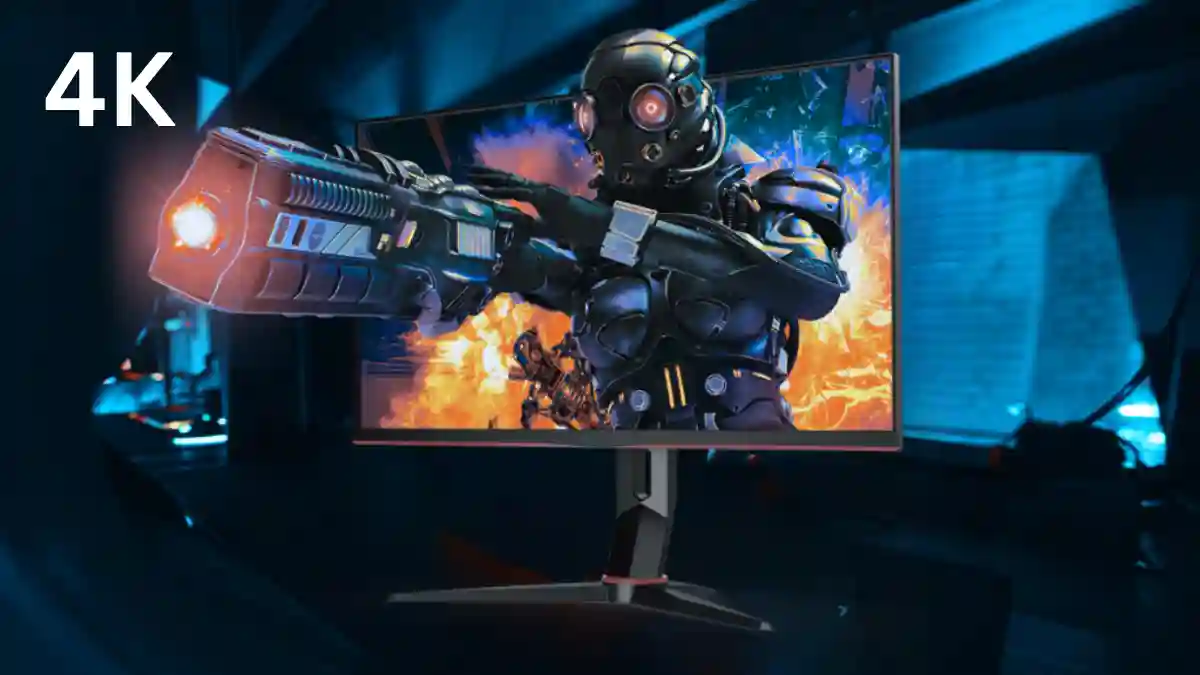4K gaming monitor can significantly enhance your gaming skills. When choosing the right 4K gaming monitor, it’s important to consider several technical and practical aspects. The monitor’s refresh rate makes your gameplay smoother.
For 4K gaming, choose right monitor at least 120Hz or 144Hz refresh rate. If your budget allows, monitors with refresh rates up to 240Hz are also available. This guide uses a simple method to help you choose Right 4K Gaming Monitor. You can buy one that works with your PC and improves your gaming. By the end, you’ll have a complete checklist of the best monitors for 2025, based on real test data.
Step-by-Step Guide to Choose Your Ideal 4K Gaming Monitor
This guide explains a 5-step approach with future technologies in mind.
Step 1: Assess Your Setup and Needs
This is the most important first step that lays the foundation for your entire purchasing decision.
GPU and system performance assessment
Minimum for 4K 60 FPS:
- NVIDIA RTX 4070 Super or AMD RX 7900 GRE
- 8-core CPU (such as Ryzen 7 7800X3D or Intel i9-14900KF)
- At least 16GB of RAM (32GB recommended)
Premium for 4K 144Hz+:
- NVIDIA RTX 4080 Super/4090 or AMD RX 7900 XTX
- 12GB+ VRAM required
- 850W–1000W PSU
According to source, If your GPU cannot handle 4K, an expensive monitor will be of no use. If you currently have a weaker system, a 1440p monitor may be a better option.
Identify your gaming style
Competitive Gaming:
- 24-27-inch monitor preferred
- 240Hz+ refresh rate required
- 1ms or less response time
- Low input lag important
Casual/Single-player Gaming:
- 27-32-inch monitor more immersive experience
- 144Hz refresh rate sufficient
- HDR and color accuracy more important
RELATED POST- What Is 4K Gaming?
2. Master the Must-Have Specs
You must deeply understand the technical specifications at this step.
Choosing the Refresh Rate
Available options:
- 60Hz: Basic, suitable only for story-based games
- 144Hz: Standard, ideal for most gamers
- 240Hz: Common in competitive gaming and OLED monitors
- 480Hz: Found only in premium WOLED monitors, offers extremely smooth motion
How to choose: Select based on your GPU’s capability. For 4K@240Hz, a powerful GPU like the RTX 4090 is required.
HDR Capability
Minimum requirements:
- DisplayHDR 600 or higher certification
- 400 nits+ peak brightness (600 nits ideal)
- 10-bit color depth (or 8-bit + FRC)
- 90%+ DCI-P3 color gamut coverage
Benefits of HDR: More vibrant colors, better contrast, and deeper blacks.
Connectivity Requirements
Essential ports:
- DisplayPort 2.1 (UHBR 20): Best for future use, supports 4K@240Hz
- HDMI 2.1: Necessary for console gaming (PS5, Xbox), supports 4K@120Hz
- DisplayPort 1.4: For PC gaming, supports up to 4K@144Hz
RELATED POST- Why Does Phone Hang and Lag While Playing Games?
3. Pick the Right Panel and Size
This stage dictates the look and how easy it is to use.
Panel Type Comparison
IPS Panel:
- Advantages: Excellent color accuracy (sRGB 100%), wide viewing angles, fast refresh rates
- Disadvantages: Low contrast (1000:1), IPS glow issue
- Price: Medium to high
- Best for: Content creation and all-round gaming
VA Panel:
- Advantages: High contrast (3000:1+), deep blacks, affordable
- Disadvantages: Slower response time, ghosting issues
- Best for: Dark-room gaming and budget setups
OLED Panel:
- Advantages: Infinite contrast, perfect blacks, 0.03ms response, vivid colors
- Disadvantages: Expensive, risk of burn-in, lower brightness (in HDR)
- Price: Premium (₹80,000+)
- Best for: High-end gaming, users seeking the best visual experience
Screen Size Decision
27-inch (4K):
- Pixel Density: 163 PPI, extremely sharp
- Advantages: Ideal for competitive gaming, minimal eye movement
- Disadvantages: Less screen real estate
- Optimal Distance: 75–80 cm
32-inch (4K):
- Pixel Density: 138 PPI, still excellent
- Advantages: More immersive, larger viewing area
- Disadvantages: Requires more desk space, less focus in competitive gaming
- Optimal Distance: 95–110 cm
163 PPI density suits a 27-inch display, which offers arm’s length viewing and pixel immersion.
Sim racing benefits from 32-inch screens, requiring 24–30-inch depth.
RELATED POST- Best VPN for Gaming in 2025: Tested for Low Ping & Speed
4. Prioritize Extras for Peak Performance
These extra features boost long-term ease of use and practicality.
Adaptive Sync Technology
Options:
- G-Sync (NVIDIA): Premium, low input lag
- FreeSync (AMD): Affordable, available in most monitors
- G-Sync Compatible: FreeSync monitors that work with NVIDIA GPUs
- Benefits: Eliminates screen tearing and stuttering.
Ergonomic Stand Features
Essential Adjustments:
- Height Adjustment: For eye-level alignment
- Tilt (Up-Down): -5° to +20°
- Swivel (Left-Right): Up to 45°
- Rotation (Portrait Mode): 90° rotation
- Benefits: Reduces neck and eye strain, improves posture.
Other Useful Features
- Built-in Speakers: For basic audio
- Cable Management: Keeps setup neat and organized
- OLED Care Features: Prevents burn-in (for OLED displays)
- PiP/PbP: View two sources simultaneously
RELATED POST- 5 Best Single-Player Games for Relaxation and Stress Relief in 2025
5. Top Recommendations for 2025
Now that you know everything, here are the best options for different budgets.
| Model | Size / Refresh Rate / Panel | HDR & Sync | Category | Price (USD) | Pros | Cons |
|---|---|---|---|---|---|---|
| ASUS ROG Swift PG27UCDM | 27″ / 240Hz / QD-OLED | Dolby Vision, G-Sync / FreeSync | Overall Excellence | $1,200 | Infinite contrast, 0.03ms response, premium processing | No speakers, premium cost |
| Cooler Master Tempest GP27U | 27″ / 160Hz / Mini-LED IPS | HDR1000, G-Sync / FreeSync | HDR Value | $850 | 576 zones, vivid QD colors, accurate calibration | No 160Hz sync, minor gamma shift |
| ASUS ROG Swift OLED PG32UCDP | 32″ / 240Hz / OLED | HDR True Black 400, G-Sync Certified | Immersive Cinematic | $1,200 | 480Hz dual-mode, KVM, high brightness | Potential burn-in risk |
| Dell S3225QC | 32″ / 120Hz / OLED | Dolby Vision / HDR10, G-Sync / FreeSync | Console/Budget OLED | $700 | Spatial audio speakers, ergonomic stand, tremendous contrast | 120Hz cap, no gamma presets |
| ASUS ROG Strix XG27UCS | 27″ / 160Hz / IPS | HDR600, G-Sync / FreeSync | Esports Precision | $470 | 163 PPI sharpness, pro color accuracy, backlight strobe | Mediocre contrast, no USB hub |
Based on RTINGS and Tom’s Hardware, these picks highlight 2025 technologies such as better UHBR bandwidth. Check out RTINGS.com 4K Gaming Monitor reviews for more detailed info.
Following these five steps in order will help you make a right decision that fits your needs now. 4K gaming monitor costs may be high, but a good one will improve your gaming for a long time.
Frequently Asked Questions
For 2025 rigs with RTX 50-series GPUs, 240Hz optimizes fluidity without excessive GPU strain.
OLED triumphs in contrast (infinite:1) and response (0.03ms), ideal for dark-scene immersion, but IPS prevails for burn-in-free longevity and viewing angles in multi-monitor setups.
Yes; RTX 4080+ or RX 7900 XTX minimum for 100+fps at ultra.
ASUS ROG Strix XG27UCS at ~$470 delivers 160Hz IPS sharpness.










